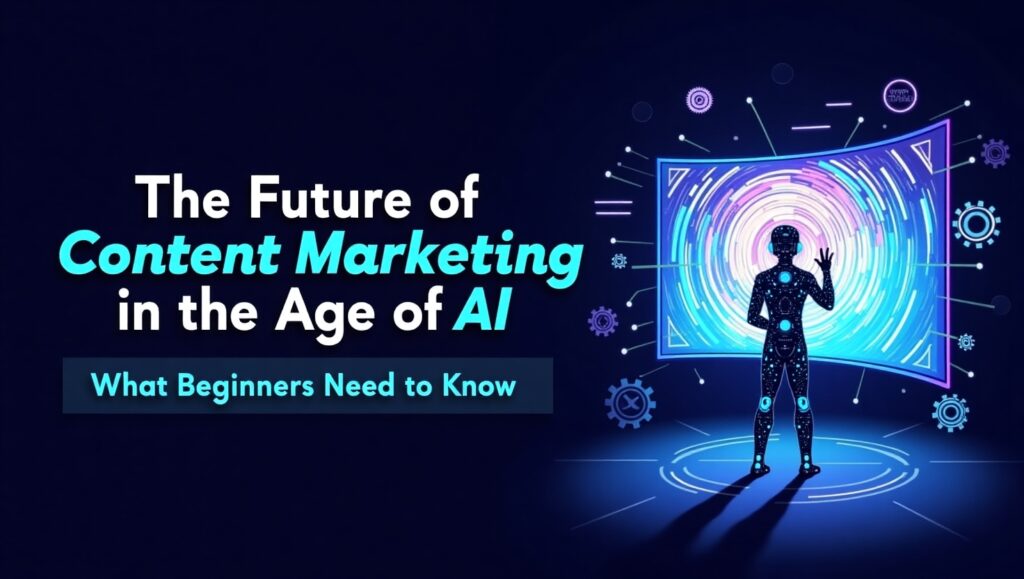Introduction: Navigating the New Digital Frontier
Are you feeling overwhelmed by the rapid pace of change in content marketing? Perhaps you’ve invested countless hours perfecting your content strategy, only to see diminishing returns as new AI technologies reshape the digital landscape. You’re not alone. As AI continues to revolutionize how content is created, distributed, and consumed, many marketers find themselves struggling to adapt their strategies and questioning their role in this new ecosystem.
The good news? This technological revolution presents as many opportunities as it does challenges for those willing to evolve alongside it.
Quick Takeaways:
- AI is transforming content creation, distribution, and analytics, not replacing human creativity
- 76% of marketers already use AI tools for content creation and optimization
- Personalization at scale is becoming the new standard, with AI enabling unprecedented targeting precision
- Human oversight remains essential for brand voice consistency and ethical content development
- Upskilling in AI collaboration is becoming a career necessity for content marketers
Let’s explore how the content marketing landscape is evolving and what you need to know to thrive in this AI-enhanced future.
The Current State of AI in Content Marketing
Before diving into future predictions, it’s important to understand where we currently stand. AI has already made significant inroads into content marketing workflows, fundamentally changing how we approach creating and distributing content.
AI Adoption Among Marketers
The integration of AI into content marketing strategies isn’t just beginning—it’s well underway. According to Semrush’s State of Content Marketing 2023 report, 76% of content marketers now use AI tools in some capacity, representing a 30% increase from the previous year. Furthermore, 88% of those who use AI tools report that they save at least 5 hours per week on content-related tasks.
Marketing teams across industries are implementing AI for various functions:
- Content creation and optimization: Generating first drafts, suggesting improvements, and enhancing readability
- SEO research: Identifying relevant keywords and content opportunities
- Data analysis: Processing large amounts of user data to inform content strategy
- Personalization: Delivering customized content experiences based on user behavior
- Content distribution: Optimizing posting schedules and channel selection
Current Limitations and Challenges
Despite rapid advancement, AI tools still face noteworthy limitations. Many organizations struggle with integrating AI effectively into their existing workflows. According to Gartner, 54% of AI projects never make it from pilot to production, often due to implementation challenges or unrealistic expectations.
Moreover, current AI systems sometimes produce content that lacks depth, originality, or emotional resonance. They may also generate information that’s factually incorrect or outdated if not properly trained or supervised.
Nevertheless, the trajectory is clear: AI capabilities are expanding exponentially, and content marketing practices are evolving in response.
How AI is Transforming Content Creation
The content creation process is perhaps where AI has made its most visible impact, dramatically changing how marketers approach ideation, production, and optimization.
From Assistance to Collaboration
Early AI content tools functioned primarily as assistants—spelling checkers, grammar correctors, and basic research aids. Today’s AI tools have evolved into collaborative partners that can:
- Generate comprehensive content outlines based on strategic briefs
- Create first drafts of articles, social media posts, and email campaigns
- Suggest headline variations optimized for engagement
- Rewrite existing content for different audiences or platforms
- Offer style and tone recommendations to maintain brand consistency
The shift from AI as a simple tool to AI as a collaborative partner represents a fundamental change in the content creation workflow. Rather than merely executing specific tasks, AI now participates in the creative process itself.
Content Scaling and Efficiency
One of the most significant advantages AI brings to content marketing is the ability to scale production while maintaining quality. According to a 2023 survey by the Content Marketing Institute, organizations using AI-assisted content creation reported a 65% increase in content output while reducing production time by 37%.
This efficiency enables content teams to:
- Produce more content across multiple channels simultaneously
- Test different content variations to identify top performers
- Maintain consistent publishing schedules without quality compromises
- Repurpose existing content into multiple formats with minimal effort
Consider how Buffer, the social media management platform, uses AI to transform single blog posts into dozens of social media snippets, email newsletter segments, and video scripts—all while maintaining message consistency and brand voice.
The Emerging Role of the Human Creator
As AI takes on more routine content tasks, the role of human creators is evolving rather than disappearing. Content marketers are increasingly focusing on:
- Strategic direction and content planning
- Creative conceptualization and unique insights
- Brand voice preservation and refinement
- Critical review and quality assurance
- Emotional intelligence and cultural sensitivity
“The future content marketer will be an AI conductor, orchestrating complex campaigns that combine machine efficiency with human creativity,” explains Ann Handley, Chief Content Officer at MarketingProfs. “The tools are getting smarter, but the strategy still needs a human touch.”
Personalization at Scale: The New Content Standard
Perhaps the most transformative aspect of AI in content marketing is the unprecedented ability to personalize content experiences for individual users at scale.
Beyond Demographic Segmentation
Traditional content personalization relied heavily on basic demographic segments—age groups, locations, or broad interest categories. AI-driven personalization delves much deeper, analyzing:
- Individual browsing and purchase history
- Content consumption patterns and preferences
- Engagement timing and device usage
- Linguistic preferences and communication styles
- Behavioral signals indicating buying intent
According to McKinsey, companies that excel at personalization generate 40% more revenue from those activities compared to average players. AI makes this level of personalization accessible even to smaller organizations without massive data teams.
Dynamic Content Experiences
As AI capabilities expand, static content is giving way to dynamic experiences that adapt in real-time to user behavior and preferences. This includes:
- Adaptive content paths: Articles that adjust their depth and focus based on reader engagement
- Interactive elements: Conversational components that respond to user inputs
- Real-time optimization: Headlines and visuals that change based on performance data
- Cross-channel consistency: Synchronized messaging across platforms that maintains context from previous interactions
Netflix exemplifies this approach, using AI to not only recommend content but also to customize the artwork shown for each title based on individual viewing history and preferences, resulting in a 20% increase in engagement.
The Privacy Paradox
With greater personalization comes increased responsibility regarding user data and privacy concerns. According to a 2023 PwC Consumer Intelligence Series survey, 86% of consumers are concerned about data privacy, yet 73% expect personalized experiences from brands.
This paradox presents both challenges and opportunities for content marketers in the AI era. Those who can deliver highly relevant experiences while respecting privacy preferences will gain significant competitive advantage.
Emerging Content Formats and Distribution Channels
AI is not only changing how we create content but also expanding what forms content can take and how it reaches audiences.
Multimodal Content Creation
Early AI tools focused primarily on text generation. Today’s systems can work across multiple content formats:
- AI-generated images and graphics that complement written content
- Voice synthesis for podcasts and audio versions of written articles
- Video generation and editing assistance for short-form content
- Interactive experiences that respond to user participation
- Virtual and augmented reality content with AI-driven elements
According to Cisco’s Visual Networking Index, video will represent 82% of all internet traffic by 2025, and AI is making video production more accessible to brands without specialized equipment or expertise.
Conversational Marketing and AI Assistants
The rise of AI chatbots and virtual assistants is creating new channels for content distribution and engagement:
- Brand-specific chatbots that deliver personalized content recommendations
- Voice assistant skills and actions that surface relevant brand content
- Conversational interfaces embedded within existing content experiences
- Automated follow-up content based on conversation context
“Conversational AI represents the next frontier in content marketing,” notes Chris Penn, co-founder of Trust Insights. “It’s not just about answering questions—it’s about continuing the brand narrative through dialogue.”
Predictive Distribution and Smart Timing
Beyond creating content, AI is optimizing when, where, and how that content reaches audiences:
- Predictive analytics that determine optimal publishing schedules
- Channel-specific optimization that tailors content format to platform preferences
- Smart retargeting that surfaces relevant content based on past engagement
- Contextual delivery that considers environmental factors like location, device, and activity
HubSpot reports that companies using AI for content distribution timing see average engagement increases of 25%, highlighting the impact of reaching audiences at their most receptive moments.
Skills for Content Marketers in the AI Era
As AI reshapes content marketing, professionals need to develop new competencies to remain valuable and effective in this changing landscape.
Technical Literacy and AI Collaboration
While deep technical knowledge isn’t necessary for most content roles, baseline AI literacy is becoming essential. This includes:
- Understanding AI capabilities and limitations
- Learning effective prompting techniques for AI tools
- Interpreting and acting on AI-generated analytics
- Evaluating AI outputs for quality and accuracy
- Knowing when to rely on AI and when human expertise is needed
LinkedIn’s 2023 Workplace Learning Report identified “AI collaboration skills” as the fastest-growing skill requirement in marketing job postings, appearing in 37% more listings than the previous year.
Strategic Thinking and Creative Problem-Solving
As AI handles more routine content tasks, human value increasingly lies in areas machines struggle with:
- Developing unique brand perspectives and positions
- Crafting emotional narratives that resonate with audiences
- Identifying unconventional content opportunities
- Creating unexpected connections between concepts
- Understanding subtle cultural contexts and implications
These distinctly human capabilities become more valuable as AI commoditizes standard content production.
Ethical Content Development
The rise of AI also brings new ethical considerations for content marketers:
- Transparency about AI usage in content creation
- Evaluating algorithmic biases in content recommendations
- Ensuring factual accuracy in AI-generated content
- Maintaining authentic human connection despite automation
- Balancing personalization with privacy concerns
According to the Edelman Trust Barometer, 81% of consumers say brand trust is a deciding factor in their purchasing decisions. Ethical AI usage in content marketing will increasingly influence that trust.
Practical Steps to Future-Proof Your Content Strategy
With all these changes underway, how can you prepare your content marketing approach for the AI-enhanced future? Here are actionable recommendations you can implement today:
1. Audit Your Current Content Workflow
Begin by examining your existing content creation process to identify:
- Tasks that consume disproportionate time relative to their value
- Areas where consistency or scale presents challenges
- Quality control points that could benefit from AI assistance
- Creative bottlenecks that slow down production
This assessment provides the foundation for strategic AI implementation.
2. Start Small with AI Integration
Rather than overhauling your entire content system at once:
- Select one specific content challenge to address with AI
- Test multiple AI tools or approaches for this single use case
- Measure results against your standard process metrics
- Document learnings before expanding to additional applications
Buffer started their AI journey by using natural language processing solely for headline optimization before gradually expanding to other content areas, allowing them to build expertise incrementally.
3. Develop a Human-AI Collaboration Framework
Create clear guidelines for how human team members and AI tools will work together:
- Define which aspects of content require human oversight
- Establish quality checkpoints in AI-assisted workflows
- Create prompt libraries for consistent AI guidance
- Document your brand voice parameters for AI tools
- Train team members on effective AI collaboration
Companies with documented AI-human workflows report 58% higher satisfaction with their AI implementation results, according to Forrester Research.
4. Focus on Value-Added Content Differentiation
Identify and emphasize content elements that AI cannot easily replicate:
- Original research and proprietary data insights
- Subject matter expertise and industry experience
- Authentic brand storytelling and perspective
- Community engagement and relationship building
- Ethical considerations and value alignment
These differentiators will become increasingly important as baseline content quality standardizes through AI assistance.
The Future Outlook: What’s Next for Content and AI
Looking ahead, several emerging trends will likely shape the evolution of AI in content marketing:
Multimodal AI Systems
Future AI content systems will seamlessly integrate text, image, audio, and video creation capabilities. OpenAI’s developments suggest that within 12-18 months, marketers will have access to tools that can generate cohesive content packages across formats from single prompts.
Augmented Content Creation
Rather than fully automating content production, the most effective approaches will likely combine AI efficiency with human creativity—what some experts call “centaur marketing.” This collaborative approach preserves brand authenticity while enhancing productivity.
Ambient Content Experiences
As smart devices proliferate through IoT expansion, content will become increasingly ambient—available when and where users need it without explicit searching. This contextual delivery will require new approaches to content structuring and metadata.
Regulatory Evolution
Expect increased regulation around AI-generated content, particularly regarding disclosure requirements and misinformation prevention. Forward-thinking marketers are already developing transparent AI usage policies ahead of potential regulatory mandates.
FAQ: Common Questions About AI and Content Marketing
Will AI replace content marketing jobs?
AI will transform content marketing roles rather than eliminate them. Routine tasks like basic research, first drafts, and performance reporting will increasingly be automated, but human expertise remains essential for strategy, creativity, emotional intelligence, and ethical oversight. The Bureau of Labor Statistics actually projects 10% growth in marketing specialist roles through 2026, with increasing emphasis on strategic and creative skills.
How can small businesses compete with enterprise AI resources?
The democratization of AI tools is actually leveling the playing field for smaller organizations. Cloud-based AI platforms offer subscription access to sophisticated capabilities without requiring technical teams or massive investments. Small teams can focus on distinctive brand voice and customer relationships while using AI to achieve production efficiencies previously available only to larger competitors.
How do we maintain brand authenticity with AI-assisted content?
Authenticity requires clear brand guidelines for AI implementation, including voice parameters, value expression, and subject matter expertise boundaries. Successful brands treat AI as a collaborative tool rather than a replacement for human judgment, using it to enhance rather than determine their communication approach. Regular review of AI outputs against established brand standards helps maintain consistency.
What metrics should we track to evaluate AI’s impact on our content?
Beyond standard content performance metrics, consider measuring:
- Production time savings
- Content volume and publishing consistency
- Topic and format diversity
- Personalization effectiveness
- Team satisfaction and creative output quality
- Return on content investment
The most valuable metrics connect content activities to business outcomes rather than focusing solely on production efficiency.
Conclusion: Embracing the AI-Enhanced Content Future
The integration of AI into content marketing represents not just a technological shift but a fundamental evolution in how we connect with audiences through digital experiences. While the pace of change may seem daunting, particularly for those new to the field, the core principles of effective content marketing remain constant: understanding your audience, providing genuine value, and building meaningful relationships.
What’s changing is our capacity to deliver on these principles at scale, with greater precision and efficiency than ever before. AI isn’t replacing the human elements that make content resonant and impactful—it’s amplifying them.
The most successful content marketers of tomorrow won’t be those who resist these changes or those who blindly automate everything. Rather, they’ll be the ones who thoughtfully integrate AI capabilities into human-driven strategies, leveraging technology to enhance creativity rather than replace it.
As you begin or continue your content marketing journey in this AI-enhanced landscape, focus first on understanding your unique audience needs and brand differentiation points. Then explore how AI tools can help you deliver on those elements more effectively. The future belongs not to the algorithms, but to those who best harness them to serve authentic human connection.
What step will you take today to prepare your content approach for this evolving future?



Pingback: How to Use AI Tools to Enhance Your Marketing: A Beginner's Guide - Ziblim Media